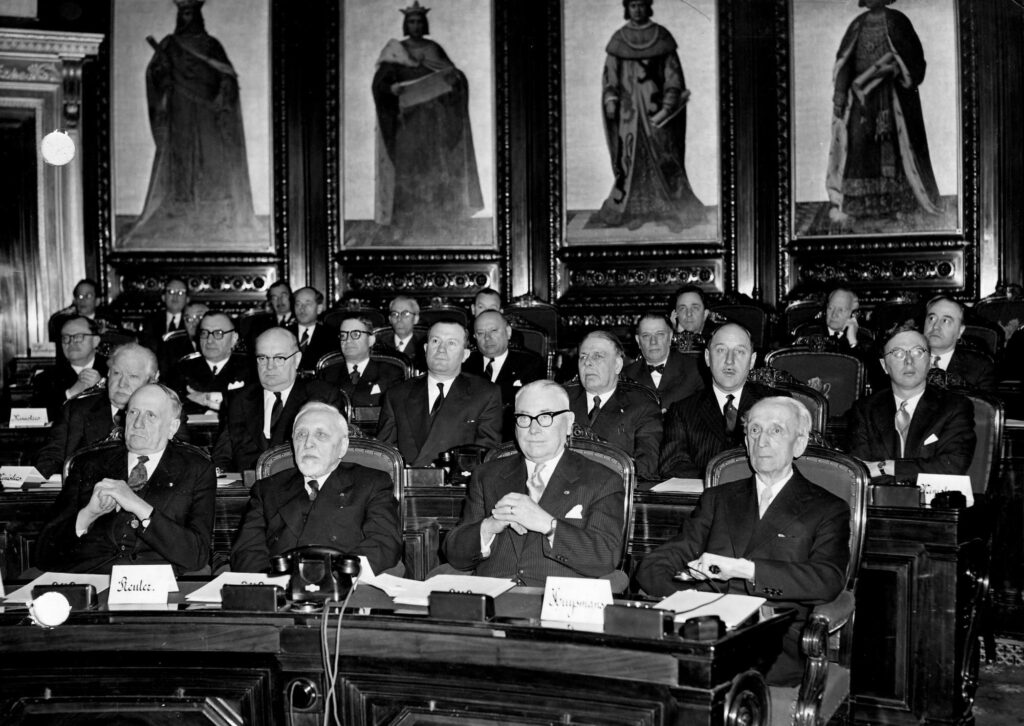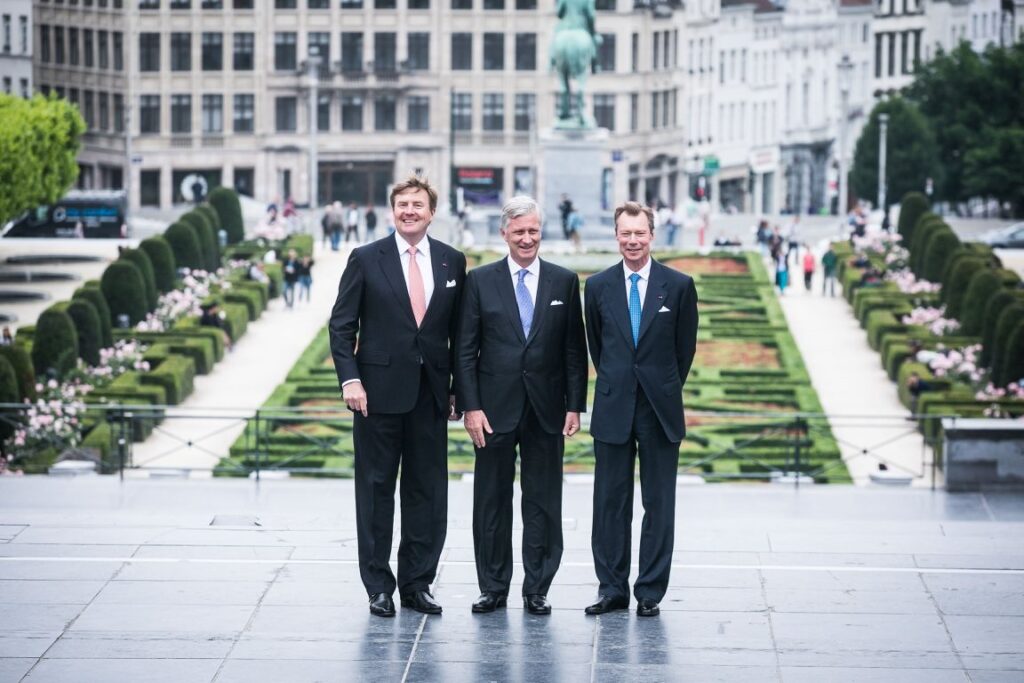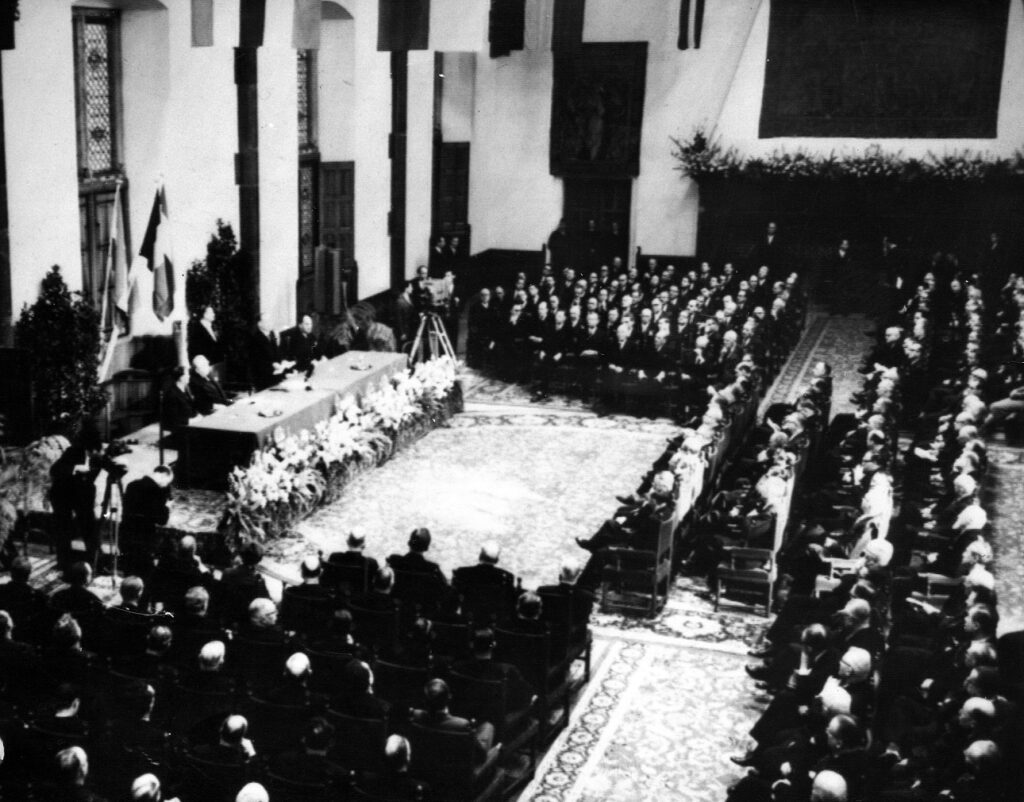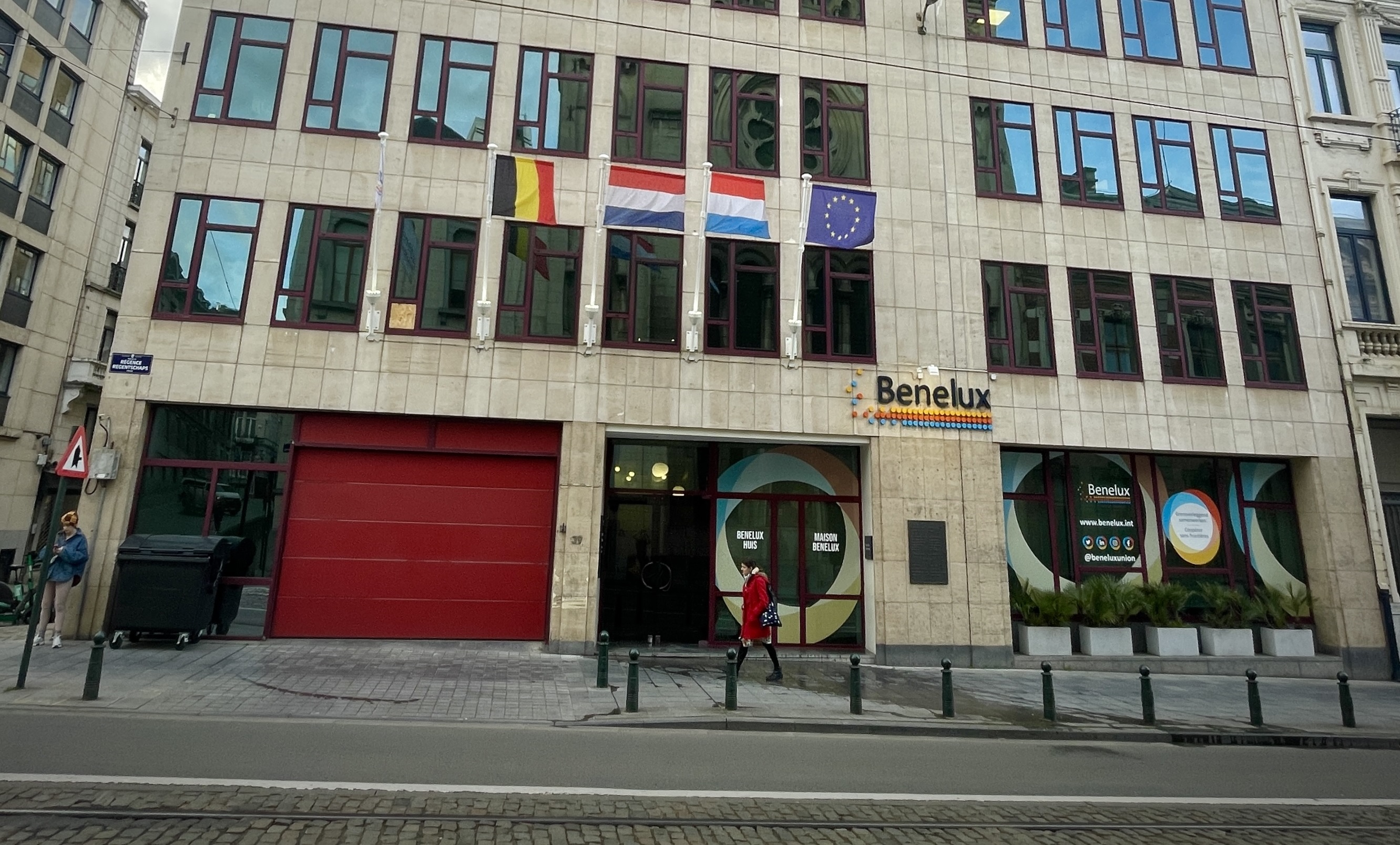Among the many tourist attractions to be found in Brussels, Mini-Europe is surely one of the strangest: a seemingly random collection of models of landmarks from elsewhere in Europe, 1/25th of their real size, to which has been applied a sugar-coating of idealism about the European Union.
Tourists, having trekked out to Laeken to visit that enduring remnant of the 1958 World Expo, the Atomium, find themselves, faute de mieux, taking photographs of their children jarringly out of scale next to the Arc de Triomphe, the Leaning Tower of Pisa or the Brandenburg Gate.
What the tourists don’t know, nor yet many residents, is that the centre of Brussels boasts another mini-Europe. It lies on the tourist trail – just after the Grand Sablon as you head towards the Palais du Justice – but it is not a tourist attraction. It is just a plain 1970s office, no architectural beauty, so why would the tourists spare a second glance for it? Yet from this building flowed agreements that have changed the lives of millions of tourists and travellers.
Rue de la Régence 39 is the home of the Benelux Union, a multifaceted alliance between Belgium, the Netherlands and Luxembourg that contributed its DNA to what grew up to be the European Union.
But this organisation is more than a historical curiosity. It is still shaping what the EU becomes and serving as a guinea pig for experiments in international co-operation.
Benelux benefits
To those who ask, “What has the Benelux ever done for us?”, the one-word response ought to be: Schengen. Now a byword for passport-free travel across the European continent, Schengen is a tiny settlement in Luxembourg that, like many places in the Grand Duchy, has more petrol stations than its population could possibly need.
Schengen is on the west bank of the Moselle and it was on a boat on the river that the Schengen Agreement was signed in 1985 between France, Germany, Luxembourg, Belgium and the Netherlands, by which the five countries committed themselves to the progressive dismantling of border controls.

The first meeting of the Benelux Consultative Committee, 18 April 1957
From that grew the Schengen travel area that we know today, which covers 25 EU countries (Romania and Bulgaria were admitted on March 31 this year; Cyprus is in the waiting room; Ireland remains outside) plus four non-EU countries: Switzerland, Lichtenstein, Norway and Iceland. Being the point at which Benelux borders France and Germany, Schengen was a logical symbolic choice for the signing, because the three Benelux countries had already abolished their internal border controls as part of the Benelux Economic Union.
The difficulties - political, legal, technical – of border-free travel had been worked through by the Benelux in the preceding years, and it was in Brussels, in Rue de la Régence, that the Schengen Agreements were negotiated.
Bureaucratic triumvirate
Jean-Claude Meyer shows me around the conference room where the Schengen negotiations happened. As we walk along the corridor for a magnificent panoramic view over Brussels, he tells me that he witnessed the Schengen negotiations in the 1980s when he was a junior Luxembourg diplomat. He went on to ambassadorial postings in Liechtenstein, Switzerland, and at the EU and now Meyer is the Luxembourger in a (wholly masculine) triumvirate at the top of the secretariat of the Benelux Union, one of two deputy secretaries-general.
The other is Michel-Etienne Tilemans, another diplomat-bureaucrat whose career includes postings as Belgium’s ambassador in central Africa and in Tunisia and Libya, and a stint as ambassador to the EU’s political and security committee.
The secretary-general is a Dutchman, Frans Weekers, who is a politician turned bureaucrat, a liberal (VVD) member of the Dutch parliament for 11 years, then state secretary of finance in two successive national governments (2010-2014). Supported by a staff of about 50, they constitute the permanent leadership of the Benelux – its college – who occasionally corral or cajole national ministers and administrations into action.
Between them, these three senior officials boast extensive experience in their respective national administrations. That has equipped them with a nuanced awareness of where the three states might find common ground. They are not interested, Tilemans says, in finding only the lowest common denominator in a particular policy area. Rather, they want to find where trilateral co-operation might bring significant “added value” – by which they mean benefits that they could not get through bilateral agreements or through the 27-strong EU.
We discuss a readiness to use bigger, heavier lorries in the Benelux – tough on the infrastructure, but it might mean fewer lorry journeys and lower emissions. Cross-border energy projects are also on the list. The mutual recognition of qualifications is meant to address a persistent obstacle in the EU’s supposedly single market.
Sharing fiscal and social security information is the subject of a treaty to be signed this year – for instance to help labour inspectorates in the respective countries to counter abusive working conditions and social security fraud. It might not amount to another Schengen, but it meets Weekers’s ambition “to be a testing ground for what happens in the EU”.

Dutch King Willem-Alexander, Belgium's King Philippe and Luxembourg's Grand Duke Henri at a 60th anniversary celebration of the Benelux Economic Union in 2018.
That police and judicial co-operation should be a priority is unsurprising. Crime, particularly in this overcrowded corner of north-west Europe, is no respecter of national borders. The Netherlands and Belgium have, in Rotterdam and Antwerp, the EU’s two most important ports of entry for freight, increasingly targeted by drug smugglers and other organised crime.
A strengthened Benelux treaty on police co-operation came into force in October last year. It allows a police force of one country to pursue suspects across national boundaries and to cross boundaries in pursuit of information and witnesses. The sharing of information between police forces on either side of the frontiers becomes routine and the frontier areas are very generously defined.
Benelux redux
For the EU, these fields of justice and home affairs are still young and EU law-making on security is still highly contentious, given that it treads on jealously-protected national prerogatives and runs up against differences in judicial traditions. You can see why the Benelux might not wait for the EU and how Benelux might blaze a trail for the EU.
Success is not certain, however. I remind Weekers that during the 2008 banking crisis, the governments of Belgium, the Netherlands, Luxembourg and France, meeting just a few hundred metres away along Rue Royale, broke up the Fortis and Dexia banks into their component national parts, putting into reverse the previous decades of European banking consolidation.
“In times of high crisis, you see that countries tend to national solutions – as we also saw in the Covid crisis. For me, that’s a pity. I don’t like it: it undermines public support for cross-border co-operation in the medium term,” Weekers responds. “But in the longer term, you can rebuild.” The remedy, he argues, is to have plans in place, to rehearse crisis responses, and to equip international configurations like Benelux with the means to act in emergencies.
Tilemans argues that the Benelux countries, while they do not think alike on every subject – our discussions have touched, among other things, on nuclear energy, data privacy and banking secrecy – yet they share a common outlook as small countries in the EU and with a strong commitment to it.
What he is too polite – or diplomatic – to say is that these three countries still enjoy some special status as founding members of the. EU. Amid the occasional talk of whether the post-Brexit EU will disintegrate further – triggered perhaps by Hungary’s recalcitrance, perhaps by another spasm of migration or a resurgent eurozone crisis, perhaps by some new threat – few doubt that the Benelux will stick together. This mini-Europe is not subject to the vagaries of fashion.
How Benelux works
The institutional architecture of the Benelux will be very familiar to those who know the European Union.
The Benelux Committee of Ministers is the supreme decision-making body, composed of ministers from the governments of the three countries. Precisely which ministers attend a particular meeting will vary according to the policies under discussion.
The Benelux Council is composed of senior officials from the administrations of the three countries who prepare meetings of the Committee of Ministers.
The Benelux secretariat-general is a permanent staff of about 50 that co-ordinates the work between the three national administrations on Benelux matters. The secretary-general and two deputy secretaries-general form the College, which leads the work of the secretariat.
The Benelux parliamentary assembly has 49 members – 21 from the Netherlands, 21 from Belgium and 7 from Luxembourg – elected from the parliaments of those countries. Its meetings rotate between the three countries.
The Benelux court adjudicates on matters of Benelux law that might, for example, be brought in disputes over trademarks and tax matters. The nine judges of the court are drawn from the upper courts of the three countries.
Four score and more years of Benelux history
Benelux began as an experiment in international co-operation triggered by war. The first step was the Belgium–Luxembourg Economic Union (BLEU) in 1921. That agreement was itself a hangover from the First World War: Luxembourg was part of the German Customs Union, the Zollverein, until 1919.
The Versailles Peace Treaty preserved the Grand-Duchy’s independence because neither France nor Belgium was prepared to see it absorbed into the other, but the price was closer economic ties with Belgium – a lifting of the customs barrier and linking of the currencies.
In 1943, the governments in exile in London of Belgium, the Netherlands and Luxembourg concluded a monetary agreement to fix the exchange rate between the Dutch florin and the Belgian/Luxembourg franc. It was followed a year later by a treaty on a customs union between the BLEU and the Netherlands. The 80th anniversary of its signing will be marked in September this year.
[caption id="attachment_1049044" align="alignnone" width="1024"] Benelux Economic Union treaty signing ceremony in The Hague[/caption]
Benelux Economic Union treaty signing ceremony in The Hague[/caption]
The governments knew that their economies were crippled and they were ready to try adventurous remedies. The agreement, the ministers declared, was “of a transitional nature, intended to facilitate the restoration of economic activity and to create conditions conducive to the subsequent achievement of a lasting union.”
According to Paul-Henri Spaak, who was then Belgium’s Foreign Minister, one of the obstacles to be overcome was the Dutch government’s reluctance to do anything that might displease the British. Another was an array of technical objections from civil servants when it came to peacetime implementation.
Nonetheless, the politicians reaffirmed their intentions in a protocol signed at The Hague in March 1947 and the customs union took effect at the start of 1948. A further treaty, signed in 1958, advanced the economic co-operation still further, bringing the Benelux Economic Union into effect in 1960, with the aim of free movement of persons, capital, goods, and services.
Hindsight distorts our view. It was not inevitable that the European Economic Community (EEC) would start out with six members: at the end of the 1940s, France and Italy had plans for a customs union with the Benelux that would have excluded West Germany, but ‘Fritalux’ was thwarted by Dutch hesitation.
Nor was its success inevitable. However, the EEC was not intended to compete with Benelux. The EEC’s founding treaty contained a clause that has been carried over into a subsequent EU treaty that its provisions “shall not preclude the existence or completion of regional unions between Belgium and Luxembourg, or between Belgium, Luxembourg and the Netherlands to the extent that the objectives of these regional unions are not attained by application of the treaties”. In other words, the EU cannot hold the Benelux countries back from closer co-operation.
The treaty on the Benelux Economic Union contained a sunset clause limiting its life to 50 years, in the absence of a specific act of renewal. That deadline of 2010 was, according to Jean-Claude Meyer, “a watershed moment”. The three countries consciously chose to prolong their union with a revised and enlarged vision – renamed simply the Benelux Union – signed in 2008, both by the national governments and by the regional governments of Belgium, reflecting the federalisation that had taken place since the earlier union.
There have since been treaties on the automatic recognition of university degrees and police co-operation. A treaty on cross-border co-operation on combatting social security fraud and dangerous working conditions is scheduled for signature this year.

